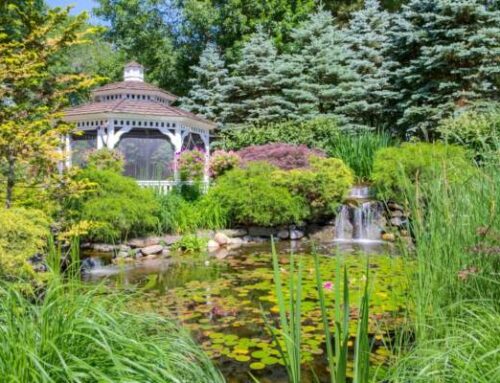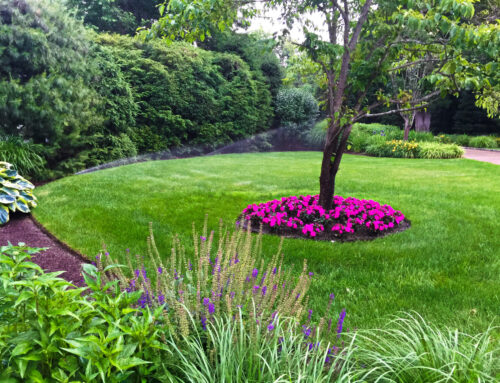Sure, that towering stone wall with the drawbridge over the moat will give you the privacy you crave.
But that seems a bit extreme, doesn’t it?
How about using beautiful privacy shrubs and trees? Let’s take a look at some of the best privacy trees and shrubs for a natural fence.
Top Natural Fence Ideas
Think about what you want from your trees and privacy plantings. Evergreens are great for reducing noise and providing screening all year long.
Deciduous trees offer spring flowers or fall colors, but when their leaves fall, you lose the privacy effect. That may be fine if you’re most concerned about three-season privacy.
How high do you want the screen to be? You’ll need to match that height to the growing height of the plants you choose.
If you’d like that privacy sooner rather than later, you’ll want plants that grow quickly.
Taking your backyard to the next level begins by contacting us here or with a simple phone call to Neave Landscaping at one of our three convenient locations:
-
In the Hudson Valley NY, area, call 845-463-0592.
-
In Westchester County NY, dial 914-271-7996.
-
In Fairfield County CT, contact us at 203-212-4800.
Hedges For Privacy
Hedges are the classic privacy screen. Sheared privet hedges are probably the most common They can be cut to almost any height and offer a nice, clean look.
Arborvitae is another popular choice. Green Giant Arborvitae is a popular fast growing hedge that can grow up to 60 feet tall. It can grow as much as 3 feet in one year.
Emerald Arborvitae grows 10 to 15 feet tall but can be trimmed shorter.
Use Layers Of Plantings
It’s tempting to plant a formal row of all the same kind of tree or shrub in a straight line, evenly spaced. But your living privacy fence doesn’t have to mimic an actual fence. Choosing just one type of plant for your screen means if a disease hits or a bug finds it tasty, you could lose the whole thing.
Consider a layered mix of privacy plantings. This creates privacy and a robust, beautiful look for your landscape. A mix of trees, shrubs, and perennials is more visually interesting than a simple line of evergreens or a hedge.
A mix of evergreens and deciduous shade trees are great as the foundation. Then layer in assorted shrubs, perennials, and annuals to create an appealing blend of texture, color, and privacy.
Choose plants in contrasting hues of green and blue, some with berries and some with blooms, for an interesting mix year round. This plan has a bonus: it creates shelter and food that attract birds, butterflies, insects and pollinators to keep your garden healthy.
Don’t forget to incorporate perennials, ornamental grasses, and annuals into your privacy plantings for interest and variety. Choose your favorites. Container plants can work well, too, especially clustered on the deck or patio for another layer of privacy.
5 Best Trees for Privacy
Privacy trees are a great idea for the back of your natural privacy fence. Each of the following tree types are popular choices for our region, providing increased privacy as they mature:
- Concolor fir has soft, bluish needles and holds up well to sun and wind exposure. Sniff when you walk past it for a pleasant, citrus-like scent.
- Hedge maple is smaller than other maples, reaching 25 to 35 feet with a growth rate of about one foot per year. A low maintenance tree, it’s happy in almost any soil.
- European hornbeam offers more privacy as it grows. Its canopy spread becomes very dense over the years.
- The Leyland cypress grows at a speedy rate of 3 feet or more per year, so it’s a popular choice for privacy screens. This beautiful evergreen has medium to dark green foliage.
- Grow hardy Amur maple as a small tree or large hedge and enjoy its spectacular red color in the fall. If you use it as a hedge, allow multiple trunks to grow, and shear their limbs occasionally to promote branching.
Small Privacy Trees
Carefully positioned small trees, especially those that branch out at the base, also help create privacy in a mixed screen. Here are a handful to consider:
- magnolias
- flowering dogwoods
- Japanese maple
- Japanese tree lilac
7 Shrubs For A Natural Outdoor Screen
A mix of interesting shrubs is a great idea for the middle of your natural privacy fence. Each of these brings its own interest to the party:
- Ninebark is a fast grower with foliage in bold shades of purple or gold, depending on the variety. Its peeling bark creates winter interest.
- Variegated red-twig dogwood boasts pretty, variegated leaves and small white flowers, followed by interesting white berries with hints of blue and green. In winter, you’ll enjoy its beautiful red bark.
- Japanese euonymus is a fast-growing evergreen shrub that can reach 10 to 15 feet tall, but it’s easy to shear back to create a lower hedge. Choose varieties with variegated foliage for an extra visual punch in your privacy border.
- Juniper might seem boring, but it’s a versatile workhorse in a privacy border. Varieties range from ground-hugging creepers to mounded shrubs and upright trees. All respond well to , a good quality in a hedge.
- Korean lilac, an 8-foot-tall shrub, is one of the easiest lilacs to grow. It offers fragrant purple flowers in May.
- Hybrid yew, a versatile evergreen, grows well in sun or shade and comes in many different varieties, some with mounded growth and some more upright.
- Choose the “Blue Muffin” variety of arrowwood viburnum and you get a bit of everything: creamy white flowers in spring, blue fruit in late summer and pretty yellow, red, or purplish foliage in fall.
Read Before Planting
Are there power lines above the area where you want your privacy screen? You don’t want trees so big that they’ll grow into the wires.
Pay attention to the plants’ width at maturity and leave enough space between plants for them to grow. It’s a common mistake to be impatient and plant trees and shrubs too close together for instant privacy. But if your plants get too crowded, they can lose foliage and branches.
Most plants that work well as privacy screens need sun in order to keep their foliage nice and full. Be sure your planting area gets at least 6 hours of direct sunlight a day.
Let Neave Create Your Landscape Sanctuary
Neave Landscaping offers affordable tree services and will help you select the best privacy shrubs, trees, and perennials for a natural privacy fence. We know how high plants grow and how fast. And we know how to layer them for a landscape look that offers both privacy and beauty.
If you’re in the Hudson Valley, call us at (845) 463-0592. If you’re in Westchester County, call (914) 271-7996; from Connecticut, dial (203) 212-4800. Or, fill out our contact form, and we’ll contact you about setting up your free consultation.







